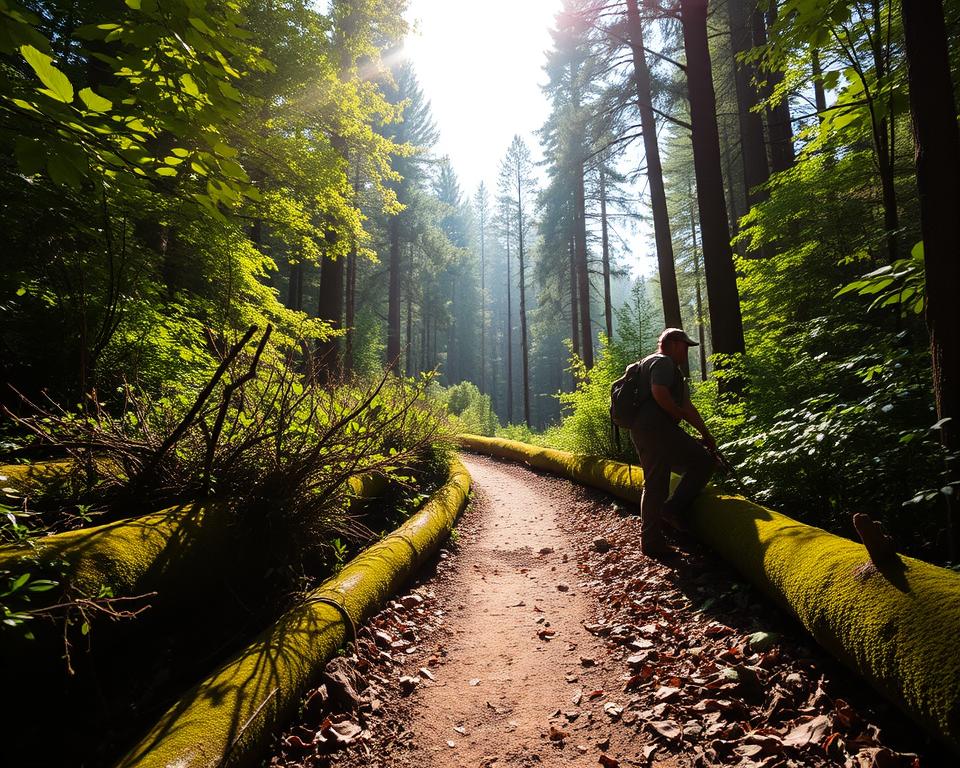Professional Advice: Open Paths in Wooded Property
Have you realize nearly eighty percent of property owners with woodland grounds rarely explore past their yard? This figure underscores the vital need for productive trail opening and upkeep. Clearing routes and footpaths in wooded areas not only boosts reachability but also enhances security and wayfinding. The following article will delve into professional techniques and insights from seasoned trail builders.
They will share ways to design well-constructed pathways that maximize your nature space’s usefulness while maintaining its ecological wholeness. Uncover the key factors for forestry mulching near me and approaches for effective wooded grounds maintenance services. Such can make your journey through your natural surroundings more enjoyable.
Significant Points
- Comprehending the importance of clearing paths for reach and security.
- Assessing location attributes to determine the objective of your paths.
- Utilizing the right equipment for efficient path clearing.
- Choosing suitable surfaces that match with landform.
- Adopting eco-friendly methods when clearing trails.
- Recognizing common mistakes to avoid during the path-opening process.
Why Clearing Trails in Forested Grounds Matters
Preserving open routes in forest zones is vital for multiple purposes. It significantly improves ease of access, making it easier to traverse dense bushes. This permits property owners and visitors to fully enjoy the landscape. This clearing also facilitates various activities like hiking, bird watching, or simply enjoying nature.
Enhancing Accessibility
Open paths not only facilitate travel; they also strengthen our connection with nature. By improving access, owners open up the outdoors to a wider audience. Such benefits is useful for personal use or group gatherings, fostering discovery and appreciation of the surroundings.
Promoting Safety and Navigation
The importance of security on woodland trails is paramount. Defined paths offer straightforward navigation and minimize hazards from uneven terrain, hidden obstacles, or sudden plant growth shifts. Property owners invest in creating safe paths, boosting confidence in outdoor exploration.

Planning Your Woodland Trail
Effective trail planning requires a deep knowledge of the terrain. It is about evaluating terrain and location conditions. Understanding the path’s purpose is also crucial, as it informs construction and upkeep.
Assessing Ground and Location Attributes
When assessing ground, several factors are essential. They include:
- Soil types that affect water flow and steadiness
- Slope degree affecting ease of access and safety
- Current plant life that may require clearing or protection
By evaluating these factors, paths can endure different weather conditions. They also accommodate frequent pedestrian use. This approach ensures the path is durable and respects the ground’s original characteristics.
Defining Your Trail’s Purpose
Trail design success depends on a well-defined purpose. Think about the activities the path will support, such as:
- Recreational walking and nature enjoyment
- Entry for upkeep or land management
- Opportunities for wildlife observation and learning
Understanding the trail’s goal directs multiple decisions. Such understanding includes the trail’s width and construction materials. Identifying the path’s objective is vital for crafting a path that fulfills its requirements.
Essential Equipment for Path Opening
Productive trail opening demands the proper tools for various tasks. The correct tools increase efficiency and security, streamlining the procedure. The selection between hand tools and motorized equipment varies with the task’s size, terrain, and amount of debris.
Fundamental Handheld Tools
Manual implements are key for accuracy and versatility in opening overgrown zones. Crucial implements include:
- Loppers: Great for cutting through heavy limbs and bushes.
- Hand saws: Ideal for detailed slicing on wood limbs.
- Digging tools: Handy for excavating and forming drainage ditches.
Such instruments provide a hands-on approach, crucial for sensitive spots where machinery could damage.
Motorized Tools for Speed
For big path clearing jobs, motorized devices are a major advantage. Such equipment make the process speedier and more efficient. Crucial tools include:
- Chain saws: Excellent for cutting down big timber and slicing thick underbrush.
- Brush-cutters: Fast for clearing thick grass and smaller shoots.
Power equipment reduces clearing duration, making it ideal for extensive zones. Secure operation is critical to avoid injuries.
Approaches for Path and Trail Preparation
Clearing paths and trails in forest areas requires careful planning. It’s vital to mediate functionality with eco-friendliness. Effective plant control maintains the environment’s harmony while creating useful pathways. This equilibrium is crucial to a pleasant exterior encounter.
Removing Excess Growth
Selective clearing methods are essential when tackling excess vegetation. Manual implements enable for precise extraction of unwanted plants without damaging the habitat. Such approach promotes the flourishing of preferred plants while controlling invasive ones. Regular upkeep prevents resurgence, enhancing path safety and accessibility.
Creating a Sustainable Pathway
A eco-conscious path layout is more than aesthetic; it includes selecting materials that reduce soil loss and enhance water runoff. These strategies respect the natural landscape and lessen environmental harm. Employing local rock or recycled timber bolsters durable sturdiness and ecological harmony. Thoughtful planning strikes a equilibrium between usability and eco-protection.
Trail Flooring Choices
Choosing the right path covering is critical for both usability and durability. The choice between natural and artificial coverings affects upkeep, comfort, and path lifespan. Understanding the various materials and their fitness for your ground is crucial to establishing an ideal path.
Natural vs. Man-Made Surfaces
Organic ground covers, such as pebbles, broken rock, or mulch, are often more affordable. They blend well with the environment, facilitating drainage and a natural appearance. In comparison, man-made surfaces like concrete pavers are more long-lasting and appropriate for intensive traffic. Every option has its benefits and drawbacks, based on the planned application and climate factors.
Selecting Materials per Ground Type
Choosing the right materials includes considering ground composition, water requirements, and cost constraints. Here’s a basic guide to popular options:
| Material | Advantages | Disadvantages | Cost per Square Foot |
|---|---|---|---|
| Gravel | Inexpensive, Effective water flow | Requires regular top-up | $1 – $3 |
| Crushed Stone | Stable surface, Natural look | Can be difficult to walk on in wet conditions | $2 – $5 |
| Wood Chips | Eco-friendly, Comfortable to walk on | Needs frequent topping up | $1 – $2 |
| Concrete Pavers | Durable, Low maintenance | More expensive initially | $5 – $15 |
Thoughtfully selecting trail surface materials ensures your routes are functional and enhance the site’s scenic appeal.
Constructing Elevated Walkways
Establishing paths in forest grounds requires careful planning of level shifts. This is crucial for even transitions across different terrains and maintaining path accessibility over time. Constructing bridges for trails is often required, mainly when spanning wet areas or natural depressions.
Identifying When to Add Height Variations
Elevation in trail design is often due to irregular ground. Major level changes require structures like overpasses or raised walkways to preserve path integrity. This approach helps avoid ground washout and ensures user safety, essential for both casual hikers and serious outdoor enthusiasts.
Choosing Bridge Materials for Marshy Terrain
The selection of materials for elevated walkways and bridges is critical for their safety and longevity. Logs, masonry units, or treated lumber can offer the required support against load and environmental factors. It’s important to choose materials that are water-resistant to avoid degradation and support future modifications.
Trail Maintenance and Upkeep
Maintaining trails secure and open requires ongoing maintenance. Regular inspections assist in identifying issues early, ensuring visitors have a positive time. It’s essential to upkeep trails seasonally, as weather changes can impact them. This part will discuss a detailed maintenance checklist and the benefits of hiring professional path care solutions.
Year-Round Upkeep Tasks
A thorough checklist helps trail owners keep their paths in top shape all year. Important tasks include:
- Clearing debris such as downed limbs and leaves.
- Inspecting trail surfaces for wear and tear, after bad weather.
- Assessing drainage systems to avoid water buildup.
- Repairing soil washout by supplementing gravel as needed.
- Updating signage and signs for straightforward navigation.
Expert Path Care Providers
For those requiring professional help, specialized trail maintenance services are a excellent option. They offer:
- Comprehensive trail assessments by experienced experts.
- Advanced restoration and rehabilitation of busy trails.
- Employing dedicated machinery for better surface care.
- Implementing sustainable practices to prolong path longevity.
Engaging expert path care saves time for other outdoor pursuits. It also brings in specialized knowledge.
Landscaping Surrounding Paths
Garden design is key to rendering paths visually appealing. By thoughtfully selecting plants and materials, you can create an inviting space. This not only draws visitors but also supports local ecosystems. The ideal vegetation for paths add aesthetic appeal and maintain environmental stability.
Incorporating Flora for Aesthetic Appeal
When designing pathside planting, picking the right flora is essential. Local species are perfect as they organically fit in with the environment. They require less maintenance and provide homes for local fauna. Mix blooming flora, bushes, and grasses for a diverse, attractive setting around paths.
Using Stones and Edging Materials
Border supplies like stones and pavers are vital for path form. They outline the route and add its design. These materials prevent ground washout and provide a neat contrast with vegetation. Employing varied finishes and hues can render the path more engaging.
Eco-Friendly Path Preparation
Trail clearing projects should prioritize eco-consciousness. Sustainable land management practices help protect the site’s ecological integrity. This approach makes sure trails coexist with nature peacefully.
Sustainable Practices for Land Management
Embracing eco-conscious approaches in path clearing is critical. Low-impact techniques minimize soil erosion and protect ecosystems. Selective clearing and eco-friendly supplies minimize damage.
Learning the ground and vegetation is crucial. It supports ethical land management and improves path usability.
Impact on Local Wildlife and Flora
Wildlife impact assessments are vital in path construction. They help gauge the project’s impact on local animals and flora. This permits for required changes before building begins.
Spotting critical habitats prevents environment disturbance. This equilibrium guarantees a vibrant ecosystem for every form of life.
Trail builders can create sustainable routes with thoughtful planning. This commitment to environmental sustainability and wildlife well-being enhances nature engagement. It balances recreational activities with nature’s respect.
Pitfalls to Avoid in Path Opening
Participating in path clearing requires steering clear of frequent errors to avoid ongoing problems. Identifying these errors allows for improved preparation and execution. By focusing on simple trail design and managing drainage, one can avoid costly upkeep demands.
Overengineering Trail Layouts
Trail design often succumbs to the trap of overengineering trail design. Numerous users think complex designs make trails more appealing. Yet, straightforwardness is often the key to effectiveness. Straightforward paths enhance wayfinding and maintenance, reducing obstacles.
Unnecessary turns and elaborate features can cause trail mistakes. These errors hinder usage and wayfinding, making trails less pleasant.
Ignoring Drainage Needs
Ignoring water control challenges in trails can have serious consequences. Proper drainage planning avoids logging, which can erode trails and damage landscapes. Sufficient drainage solutions are crucial for a durable path.
Making sure proper runoff from the trail protects the pathway and protects the ecosystem. This enables for a more pleasant nature excursion.
To Conclude
Path clearing is essential for those who wish to completely enjoy their wooded grounds. It improves ease of access and security, making outdoor areas pleasant for all. Forest trails provide more than mere beauty; they offer chances for leisure and learning about the environment.
Effective design and implementation are key in trail opening. Evaluating terrain and choosing the right materials are essential for creating durable routes. Regular upkeep ensures these trails safe and open, promoting a continuous connection with the outdoors.
By understanding the concepts discussed here, you can plan and upkeep paths that serve both practical and leisure needs. Embracing forest trails can transform your grounds into a haven for adventure, relaxation, and valuing nature.
